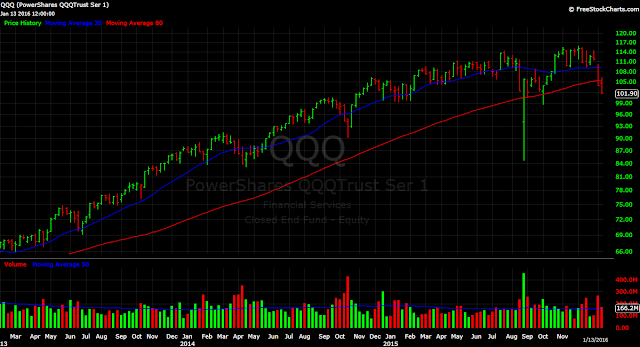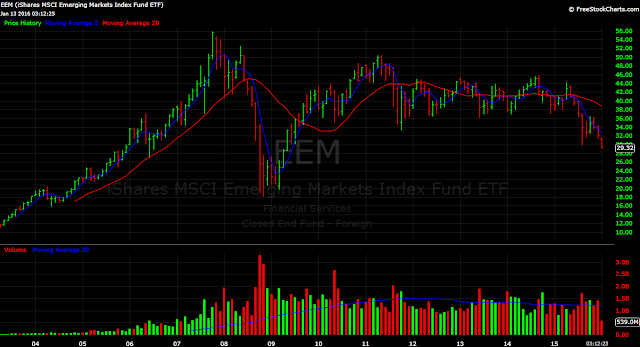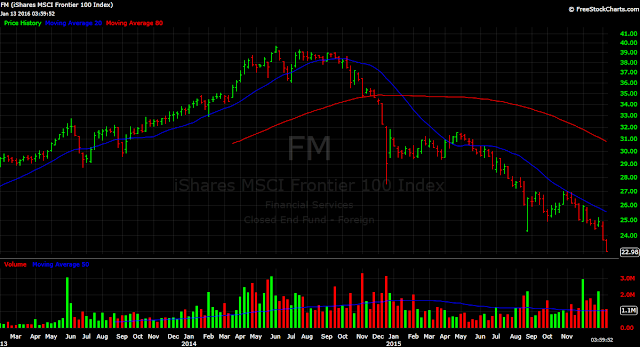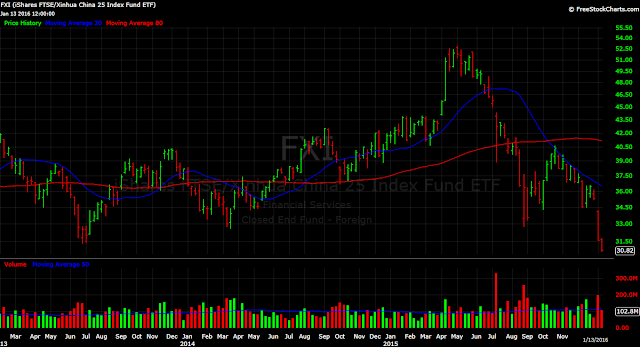Greetings, friends and readers from across the globe!
The New Year is well underway and with it, a pronounced sell-off in global share markets.
So what can we do to protect our mental capital and our financial capital in fast declining markets like these? Let's take a quick look around the world's markets and then I'll share some thoughts on the importance of playing defense in this environment.
We began 2016 with one of the worst starts on record for the US stock market. The S&P 500's market valuation plunged by over $1 trillion, erasing the combined equivalent value of tech giants Google (GOOGL), Facebook (FB), Intel (INTC), Netflix (NFLX), and Yahoo (YHOO). Meanwhile, the Financial Times reported that $2.3 trillion in value had been "sliced from companies across the globe" in the first trading week of the year. The damage was widespread:
As of today, the major US stock averages are all in negative territory. The S&P 500 ETF, SPY is down 7% year-to-date (figures via Bloomberg Markets). Nasdaq ETF, QQQ is down 9% YTD and nearly all of its 2015 gains have been wiped out. The Russell 2000 ETF, IWM is off 11% YTD and has closed at a 2-year low. Charts of all leading index ETFs included below.
In another weak sign for the US stock market, Dow Transports have plunged to a 2-year low. This coincides with recent weakness in the Dow Jones Industrial Average. These averages represent the leading industrial and transportation firms based in the USA. Continued weakness in the averages would signal a change in the primary market trend, from bullish to bearish (see this Dow Theory primer for more).
Looking at share markets across the globe, the picture is largely the same. Leading stock markets in London, Shanghai, Hong Kong, and Tokyo are all sharply lower this year. From developed markets to emerging markets and frontier markets, the weakness is evident in the charts.
Take a look at the Emerging markets ETF, EEM or the leading frontier markets ETF, FM. These are stocks (funds) in clear downtrends, whether you are viewing them on a daily chart or extending your timeframe to weekly and monthly charts. EEM has fallen to a 6-year low, while FM is trading at all-time lows.
Now look at the leading Chinese share ETFs. As I mentioned on Twitter earlier today, the Shanghai Composite is already down 16% for the year. That damage is clearly evident in the chart of the Shanghai A-shares ETF, ASHR, down 18% YTD.
FXI, which tracks 50 of the largest and most liquid Hong Kong-listed shares, is also off to a rough start. This popular and liquid China ETF is down over 12% YTD.
As you can see, the damage is clearly not limited to US stocks or European share markets. In fact, the weakness has hit markets across most asset classes, from equities to currencies and commodities.
Take a look at this updated futures performance chart (via Finviz). The clear leader at the start of 2016 is the VIX, a volatility index that shoots up when markets are shaky and uncertainty is high. Gold (GLD) and 30-year treasury bonds (TLT) are also slightly positive year-to-date, as investors rush to perceived safe havens (including highly-rated corporate bonds). Meanwhile, leading stock indices and commodities such as copper (JJC) and oil (USO) languish in the losers column. This is no walk in the park for long investors. It is a tough environment.
In markets such as these, it is best to step back and really begin to manage risk. That means cutting losses as quickly as possible, so that small losses do not grow to become devastating losses.
Resist the temptation to add to your losers in an effort to "average down". This may work for fund managers playing with other people's money, but it's a strategy best avoided when trading your own capital.
There is absolutely nothing wrong with stepping out of the fray and sitting in cash during volatile market declines. You will be able to reappraise the situation with a clear head and some money protected for better days ahead. Sometimes, when there is no clear move, it is best to do nothing.
Related posts:
1. Paul Tudor Jones and Peter Borish on trading.
2. Markets are Living, Breathing Organisms. You Must Adapt.
Subscribe to Finance Trends by email or get new posts via RSS. You can follow our real-time updates on Twitter.
The New Year is well underway and with it, a pronounced sell-off in global share markets.
So what can we do to protect our mental capital and our financial capital in fast declining markets like these? Let's take a quick look around the world's markets and then I'll share some thoughts on the importance of playing defense in this environment.
We began 2016 with one of the worst starts on record for the US stock market. The S&P 500's market valuation plunged by over $1 trillion, erasing the combined equivalent value of tech giants Google (GOOGL), Facebook (FB), Intel (INTC), Netflix (NFLX), and Yahoo (YHOO). Meanwhile, the Financial Times reported that $2.3 trillion in value had been "sliced from companies across the globe" in the first trading week of the year. The damage was widespread:
"...An analysis of more than 6,000 global stocks by the Financial Times showed more than three-fifths had fallen into bear market territory, a decline of 20 per cent or more. In total, 5,372 of the 6,178 stocks had fallen at least 10 per cent from their 52-week highs."
As of today, the major US stock averages are all in negative territory. The S&P 500 ETF, SPY is down 7% year-to-date (figures via Bloomberg Markets). Nasdaq ETF, QQQ is down 9% YTD and nearly all of its 2015 gains have been wiped out. The Russell 2000 ETF, IWM is off 11% YTD and has closed at a 2-year low. Charts of all leading index ETFs included below.
In another weak sign for the US stock market, Dow Transports have plunged to a 2-year low. This coincides with recent weakness in the Dow Jones Industrial Average. These averages represent the leading industrial and transportation firms based in the USA. Continued weakness in the averages would signal a change in the primary market trend, from bullish to bearish (see this Dow Theory primer for more).
Looking at share markets across the globe, the picture is largely the same. Leading stock markets in London, Shanghai, Hong Kong, and Tokyo are all sharply lower this year. From developed markets to emerging markets and frontier markets, the weakness is evident in the charts.
Take a look at the Emerging markets ETF, EEM or the leading frontier markets ETF, FM. These are stocks (funds) in clear downtrends, whether you are viewing them on a daily chart or extending your timeframe to weekly and monthly charts. EEM has fallen to a 6-year low, while FM is trading at all-time lows.
Now look at the leading Chinese share ETFs. As I mentioned on Twitter earlier today, the Shanghai Composite is already down 16% for the year. That damage is clearly evident in the chart of the Shanghai A-shares ETF, ASHR, down 18% YTD.
FXI, which tracks 50 of the largest and most liquid Hong Kong-listed shares, is also off to a rough start. This popular and liquid China ETF is down over 12% YTD.
As you can see, the damage is clearly not limited to US stocks or European share markets. In fact, the weakness has hit markets across most asset classes, from equities to currencies and commodities.
Take a look at this updated futures performance chart (via Finviz). The clear leader at the start of 2016 is the VIX, a volatility index that shoots up when markets are shaky and uncertainty is high. Gold (GLD) and 30-year treasury bonds (TLT) are also slightly positive year-to-date, as investors rush to perceived safe havens (including highly-rated corporate bonds). Meanwhile, leading stock indices and commodities such as copper (JJC) and oil (USO) languish in the losers column. This is no walk in the park for long investors. It is a tough environment.
In markets such as these, it is best to step back and really begin to manage risk. That means cutting losses as quickly as possible, so that small losses do not grow to become devastating losses.
Resist the temptation to add to your losers in an effort to "average down". This may work for fund managers playing with other people's money, but it's a strategy best avoided when trading your own capital.
There is absolutely nothing wrong with stepping out of the fray and sitting in cash during volatile market declines. You will be able to reappraise the situation with a clear head and some money protected for better days ahead. Sometimes, when there is no clear move, it is best to do nothing.
"The worst thing you can do when you're having a hard time is flail. In trading, when there is nothing to do, the best thing to do is nothing." - Scott Bessent (Bessent Capital).
Related posts:
1. Paul Tudor Jones and Peter Borish on trading.
2. Markets are Living, Breathing Organisms. You Must Adapt.
Subscribe to Finance Trends by email or get new posts via RSS. You can follow our real-time updates on Twitter.








